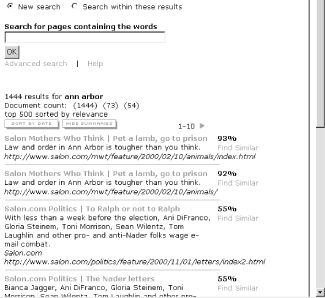Presenting Results
What happens after your search engine has assembled the results to display? There are many ways to present results, so once again you’ll need to make some choices. And as usual, the mysterious art of understanding your site’s content and how users want to use it should drive your selection process.
When you are configuring the way your search engine displays results, there are two main issues to consider: which content components to display for each retrieved document, and how to list or group those results.
Which Content Components to Display
A very simple guideline is to display less information to users who know what they’re looking for, and more information to users who aren’t sure what they want. A variant on that approach is to show users who are clear on what they’re looking for only representational content components, such as a title or author. Users who aren’t as certain of what they’re looking for will benefit from descriptive content components such as a summary, part of an abstract, or keywords. You can also provide users some choice of what to display; again, consider your users’ most common information needs before setting a default. Figure 8-10 and Figure 8-11 show a site that provides both options to users.

Figure 8-10. Salon uses search results with summaries to help users who want to learn about the documents they’ve retrieved...
Figure 8-11. ....and ...
Get Information Architecture for the World Wide Web, Second Edition now with the O’Reilly learning platform.
O’Reilly members experience books, live events, courses curated by job role, and more from O’Reilly and nearly 200 top publishers.

